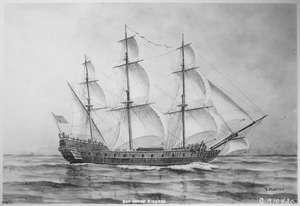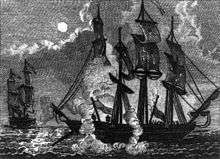USS Bonhomme Richard (1765)
 | |
| History | |
|---|---|
| Name: | Bonhomme Richard |
| Builder: | French East India Company |
| Laid down: | 1765 |
| Launched: | 1766[1] |
| Acquired: | 4 February 1779 |
| In service: | 4 February 1779 |
| Out of service: | 25 September 1779[1] |
| Fate: | Sunk |
| General characteristics | |
| Tonnage: | 998 |
| Length: | 152 ft (46 m)[1] |
| Beam: | 40 ft (12 m)[1] |
| Draft: | 19 ft (5.8 m)[1] |
| Propulsion: | Sail |
| Complement: | 380 officers and enlisted[1] |
| Armament: |
|
Bonhomme Richard, formerly Duc de Duras, was a warship in the Continental Navy. She was originally an East Indiaman, a merchant ship built in France for the French East India Company in 1765, for service between France and the Orient. She was placed at the disposal of John Paul Jones on 4 February 1779, by King Louis XVI of France as a result of a loan to the United States by French shipping magnate, Jacques-Donatien Le Ray.
Origin
Bonhomme Richard was originally an East Indiaman named Duc de Duras, a merchant ship built at Lorient according to the plan drawn up by the King's Master Shipwright Antoine Groignard for the French East India Company in 1765. Her design allowed her to be quickly transformed into a man-of-war in case of necessity to support the navy. She made two voyages to China, the first in 1766 and the second in 1769. At her return the French East India Company had been dissolved, and all its installations and ships transferred to the French Navy. As a naval ship she made a voyage to Isle de France before being sold to private shipowners in 1771.[2] She sailed in private service until she was purchased by King Louis XVI of France in early 1779 and placed under the command of John Paul Jones on 4 February.[3] The size and armament of Duc de Duras made her roughly equivalent to half of a 64-gun ship of the line.[4]
Jones renamed her Bon Homme Richard (usually rendered in more correct French as Bonhomme Richard) in honor of Benjamin Franklin, the American Commissioner at Paris whose Poor Richard's Almanac was published in France under the title Les Maximes du Bonhomme Richard.[1]
First patrols
On 19 June 1779, Bonhomme Richard sailed from Lorient accompanied by USS Alliance, Pallas, Vengeance, and Cerf with troop transports and merchant vessels under convoy to Bordeaux and to cruise against the British in the Bay of Biscay. Forced to return to port for repair, the squadron sailed again 14 August 1779. It went northwest around the west coast of the British Isles into the North Sea and then down the east coast. The squadron took 16 merchant vessels as prizes.
Battle of Flamborough Head

On 23 September 1779, the squadron encountered the Baltic Fleet of 41 sail under convoy of HMS Serapis and HM hired armed vessel Countess of Scarborough near Flamborough Head. Bonhomme Richard and Serapis entered a bitter engagement at about 6:00 p.m. The battle continued for the next four hours, costing the lives of nearly half of the American and British crews. British victory seemed inevitable, as the more heavily armed Serapis used its firepower to rake Bonhomme Richard with devastating effect. The commander of Serapis finally called on Jones to surrender. He replied, "Sir, I have not yet begun to fight!" Jones eventually managed to lash the ships together, nullifying his opponent's greater maneuverability and allowing him to take advantage of the larger size and considerably more numerous crew of Bonhomme Richard. An attempt by the Americans to board Serapis was repulsed, as was an attempt by the British to board Bonhomme Richard. Finally, after another of Jones's ships joined the fight, the British captain was forced to surrender at about 10:30 p.m. Bonhomme Richard – shattered, on fire, leaking badly – defied all efforts to save her and sank about 36 hours later at 11:00 a.m. on 25 September 1779. Jones sailed the captured Serapis to the Dutch United Provinces for repairs.
Though Bonhomme Richard sank after the battle, the battle's outcome was one of the factors that convinced the French crown to back the colonies in their fight to become independent of British authority.
Search for the wreck
Bonhomme Richard's final resting location is the subject of much speculation. A number of unsuccessful efforts have been conducted to locate the wreck. The location is presumed to be in approximately 180 feet (55 m) of water off Flamborough Head, Yorkshire, a headland near where her final battle took place. The quantity of other wrecks in the area and a century of fishing trawler operations have complicated all searches.
One season's attempts to locate and retrieve the ship, or some artifacts from her, using USNS Grasp were filmed for the Discovery Channel's Mighty Ships series in 2011.[5] The U.S. Navy's mission was unsuccessful.
See also
References
Notes
- 1 2 3 4 5 6 7 8 "Bonhomme Richard". Dictionary of American Naval Fighting Ships. Navy Department, Naval History and Heritage Command. Retrieved 30 May 2010.
- ↑ "Le Duc de Duras." Archeologie & Modelisme d'Arsenal. Retrieved 2017-03-26.
- ↑ Hill (1905), pp. 23–24.
- ↑ LE BONHOMME-RICHARD, Échelle 1/48 par Pierre et Jacques Maillière, Commentaires G.D.
- ↑ "Grasp hunts for John Paul Jones' ship". www.msc.navy.mil. October 1, 2011.
Sources
- This article incorporates text from the public domain Dictionary of American Naval Fighting Ships.
Bibliography
- Allen, Gardner Weld (1913). A Naval History of the American Revolution. II. Boston, New York: Houghton Mifflin. OCLC 2613121.
- Beach, Edward L. (1986). The United States Navy 200 Years. New York: H. Holt. ISBN 978-0-03-044711-2. OCLC 12104038.
- Cooper, James Fenimore (1856). History of the Navy of the United States of America. New York: Stringer & Townsend. OCLC 197401914.
- Hill, Frederic Stanhope (1905). Twenty-Six Historic Ships. New York and London: G.P. Putnam's Sons. OCLC 1667284.
- Maclay, Edgar Stanton; Smith, Roy Campbell (1898) [1893]. A History of the United States Navy, from 1775 to 1898. 1 (New ed.). New York: D. Appleton. OCLC 609036.
- "Navy Searches for John Paul Jones' Ship". Navy News Service. 11 September 2010. Retrieved 14 September 2010.
- Ryan, Melisa (Fall–Winter 2006). "Recapturing the Unsinkable Spirit of the Bonhomme Richard" (PDF). Wrack Lines Magazine. Groton: Connecticut Sea Grant. 6 (2). ISSN 2151-2825. OCLC 48206014. Archived from the original (PDF) on 2010-07-07.
- Smith, Roff (August 2008). "The Ghost Ship of Filey Bay". National Geographic. Washington, D.C.: National Geographic Society. ISSN 0027-9358. OCLC 6451257.
External links
| Wikimedia Commons has media related to USS Bonhomme Richard (1765). |
- Detailed Plank on Frame wooden model of the Bonhomme Richard
- Search for the Bonhomme Richard Clive Cussler recounts his elusive search for the Bonhomme Richard.